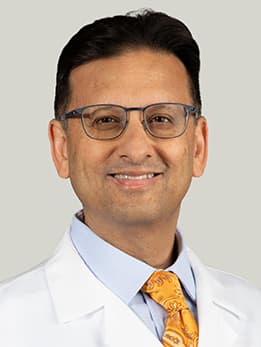Treating pain amid a public health emergency

David Dickerson, MD, (right) and fellow Jeff Hopcian, MD, discuss a patient’s case at the University of Chicago Medicine Pain Clinic
It has been labeled a crisis, an epidemic, and now a public health emergency. In the wake of President Trump’s bipartisan commission recommendations on the opioid crisis, the public is reminded of the severity and magnitude of America’s deadly relationship with substance use disorders and the common prescription pain medicine.
Pain is highly individualized and nearly every therapeutic area grapples with its presentation. In efforts to fight pain and counter the opioid crisis, physicians at UChicago Medicine are looking for the ideal balance for patients: safely and effectively easing pain with the goal of a higher quality of life.
Alternatives to opioids
David Dickerson, MD, Assistant Professor of Anesthesia & Critical Care and Director of the UChicago Acute Pain Service and the Pain Stewardship Committee, encounters complex cases that often require multidisciplinary and comprehensive treatment plans.
“In the era of the opioid epidemic, we also have a pain epidemic,” Dickerson said, referring to recent figures that estimate over 100 million Americans suffer from chronic pain alone.
With this pain epidemic comes a massive demand to alleviate it. Refining opioid-based treatments or implementing safe, effective, and accessible non-opioid alternatives is high-priority.
In 2016, Dickerson met with then-United States Surgeon General Vivek Murthy, MD and Illinois Senator Dick Durbin to discuss the opioid epidemic and various initiatives to reduce its impact.
“Before successful treatment comes patient assessment, goal-setting, expectation management, and education”, said Dickerson. “Then, the treatment needs to be empiric yet based on real-world observations, available evidence, and expert consensus”.
The Pain Medicine Team utilizes evidence-based treatments, some of which may include burning or freezing specific nerves to hinder their ability to send pain signals to the brain. Dickerson explains another technique called spinal cord stimulation, which places tiny electrodes on the spinal cord that serve as a pacemaker for the nervous system.
“Patients are equipped with a wireless remote that turns the device on or off and toggles programming. It’s really profound,” Dickerson said.
Education and outreach
In addition to cutting-edge therapies, education and outreach are significant components of the pain clinic. In recent years, Dickerson and his colleagues have implemented a stewardship program which collects and analyzes data on patterns in pain care across the medical center.
“We share the data and suggested strategies for safe and effective pain care with providers and they help us refine those processes to improve care institutionally,” said Dickerson.
Maunak V. Rana, MD, Associate Professor of Anesthesia & Critical Care and one of the seven board-certified physicians on the Pain Medicine Team, works alongside Dickerson.
“One of our key roles is to educate our patients” Rana said. “Then, instead of taking a scattershot approach to helping a patient’s symptoms, we hone in on effective techniques to precisely identify the pain source and intervene with the right solution.”
Rana and Dickerson are among more than fifty active members in the stewardship program working to improve pain management by engaging with local and national networks via collaborations with peer institutions and professional societies.
“As part of the stewardship program, we are harnessing the power of the network to work toward real and effective solutions in pain management,” Rana said. “As leaders in our field, both nationally and internationally, we are well-equipped to help patients manage their pain.”
Outside the clinic, communities continue to struggle with pain and its common counterpart, drug abuse. Thousands have been afflicted by lethal combinations that result from mixing powerful opioids, such as fentanyl, with illicit drugs, such as heroin, or even with legal drugs, such as alcohol. Thus, education and awareness programs for patients and providers have been essential.
But reaching patients can be an accomplishment in and of itself, as access to therapies remains a challenge for many. Geographical and/or insurance constraints can prevent people from receiving newer, safer treatments like those available through UChicago Medicine. Even for those with access, the discomfort of pain may never fully go away.
For any case, Dickerson emphasizes that setting goals and managing patient expectations can be just as important as the treatment itself. “We help patients recognize that we are here to help manage their pain – to help them live the life they want to live."

